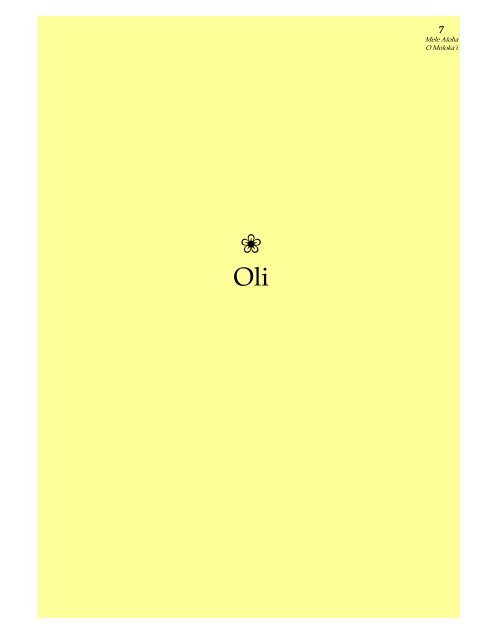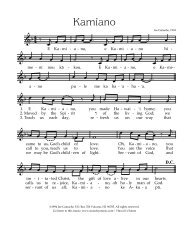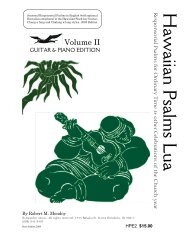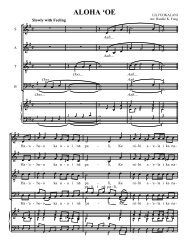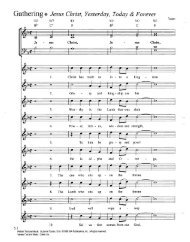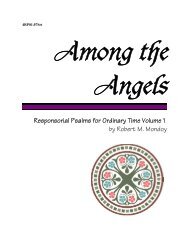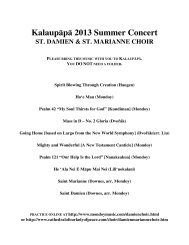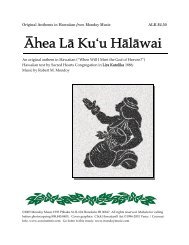Noho Ana Laka I Ka Uluwehiwehi - Mondoy Music
Noho Ana Laka I Ka Uluwehiwehi - Mondoy Music
Noho Ana Laka I Ka Uluwehiwehi - Mondoy Music
You also want an ePaper? Increase the reach of your titles
YUMPU automatically turns print PDFs into web optimized ePapers that Google loves.
‚<br />
Oli<br />
7<br />
Mele Aloha<br />
O Molokaÿi
8<br />
Mele Aloha<br />
O Molokaÿi<br />
<strong>Noho</strong> <strong>Ana</strong> <strong>Laka</strong> I <strong>Ka</strong> <strong>Uluwehiwehi</strong><br />
Nono ana <strong>Laka</strong> i ka ulu wehiwehi<br />
Kü ana i luna o Moÿoheläia<br />
ÿ<strong>Ka</strong> ÿöhiÿa kü i luna o Maunaloa<br />
Aloha mai <strong>Ka</strong>ulanaÿula iaÿu<br />
Eia ka ÿula lä, he ÿüläleo,<br />
He möhai e känaenae naÿu iä ÿoe<br />
E <strong>Laka</strong> ë, hoÿoulu ÿia!<br />
<strong>Laka</strong> Dwells in the Lush Growth<br />
<strong>Laka</strong> dwells in the lush growth<br />
That stands above Moÿoheläia,<br />
The ÿöhiÿa stands on top of Maunaloa,<br />
Love comes from <strong>Ka</strong>ulanaÿula to me<br />
Here is the ÿula, the trilling chant of affection,<br />
an offering from me, the supplicant, to you, <strong>Laka</strong>,<br />
O <strong>Laka</strong>, give me inspiration!<br />
(Translation: Sonny Ching)<br />
The summit of Maunaloa was home to <strong>Ka</strong>ulanaÿula, <strong>Laka</strong> (the patron of hula), and other gods. Moÿoheläia (an unspecified location) was said<br />
to be near Maunaloa's summit, Puÿunänä, and the area's ÿöhiÿa lehua was made famous in chant. Maunaloa, Molokaÿi is considered to be the<br />
birthplace of the art of hula, a gift of <strong>Laka</strong> to mortals. 1 An excellent discussion of this chant (and variants of it) is in Robert's Ancient Hawaiian<br />
<strong>Music</strong>, which also includes notated transciptions. 2<br />
Kumu John <strong>Ka</strong>ÿimikaua (1958-2005) was very much drawn to the origins and traditions<br />
of hula kahiko and founded with others in 1991 the Molokaÿi <strong>Ka</strong> Hula Piko as a cultural and educational event, a venue celebrating Molokaÿi<br />
(in particular Käÿana) as the birthplace of the hula. The celebrations were held at Päpöhaku Beach Park at <strong>Ka</strong>luakoÿi.<br />
Left: Puÿunänä, the 1382 ft. summit of Maunaloa, is<br />
just left of the water reservoir and communication<br />
towers. Just makai of Puÿunänä is Käÿana, a nearplateau<br />
of considerable expanse. The puÿu at the<br />
right drop-off is Kukui, and the middle one is<br />
Punakou. Länaÿi is on the horizon, just beyond the<br />
<strong>Ka</strong>lohi Channel. (Robert <strong>Mondoy</strong>, 2008)<br />
Below: Maunaloa, as seen from <strong>Ka</strong>unakakai wharf<br />
in the early morning. (Robert <strong>Mondoy</strong>, 2010)<br />
All typesets ©2010 <strong>Mondoy</strong> <strong>Music</strong> (808) 845-8405 www.mondoymusic.com. Please contact before photocopying. Mahalo!
ÿUla <strong>Ka</strong>laÿeloa I <strong>Ka</strong> Lepo A <strong>Ka</strong> Makani<br />
9<br />
Mele Aloha<br />
O Molokaÿi<br />
ÿUla <strong>Ka</strong>laÿeloa i ka lepo a ka makani<br />
<strong>Ka</strong>i hoÿonuÿanuÿa ÿia ÿäpua <strong>Ka</strong>lamaÿula<br />
ÿIkea kuÿu manaÿo i aÿu kula<br />
Hea mai <strong>Ka</strong>iolohia<br />
ÿEu hoÿi mäua i Käÿana ë<br />
Aloha iaÿu ke kula o Niniwai<br />
Oÿu hoa i <strong>Ka</strong>laÿiakamanu ë<br />
Manu a hoa laukona i ke keÿe lau<br />
Auÿa ÿia e ka moe inä ke loha lä he ÿai lili kä<br />
Aia ua ÿike au<br />
Red is <strong>Ka</strong>laÿeloa with Dust<br />
Red is <strong>Ka</strong>laÿeloa with dust raised by the wind,<br />
The dust concentrates at <strong>Ka</strong>lamaÿula as though it<br />
were a basket.<br />
At the sight of it I thought of my plain.<br />
<strong>Ka</strong>iolohia calls to me<br />
To return to Käÿana<br />
In love am I with the plain of Niniwai,<br />
With my companions at <strong>Ka</strong>laÿiakamanu<br />
(haunt of birds),<br />
Bird companions that shy away among the leaves.<br />
Love that is dreamt of is held back by jealousy,<br />
This is known.<br />
(Translation by Mary <strong>Ka</strong>wena Pukui<br />
in Nä Mele Welo)<br />
<strong>Ka</strong>laÿeloa (this area is a likely candidate)<br />
and the <strong>Ka</strong>laÿe Sugar Mill, built 1876 by<br />
Rudolph W. Meyer (1826-1897). The name<br />
of the hill overlooking <strong>Ka</strong>laÿe is Hahaeule.<br />
When I was growing up, there was a lot less<br />
shrubbery. (Robert <strong>Mondoy</strong>, 2011)<br />
<strong>Ka</strong>laÿeloa is the name of an unspecified plain after you ascend to <strong>Ka</strong>laÿe. The whole of the <strong>Ka</strong>laÿe/Naÿiwa area was a site famous for sport<br />
competitions and games. 3 From this vantage point (at least in the olden days when there were less trees) one had a vista of all the other nameplaces<br />
mentioned in the chant. <strong>Ka</strong>laÿeloa is also the name of legendary personage of the Naÿiwa sporting games area who was said to be tall,<br />
thin, and red-headed to boot. 4 <strong>Ka</strong>lamaÿula, a lttle over a mile west of <strong>Ka</strong>unakakai town, became the site of the first Hawaiian homestead lands<br />
in 1922. <strong>Ka</strong>iolohia is a plain east of Moÿomomi. Käÿana Hill is visible from Molokaÿi Airport, in ancient times famous for its ÿöhiÿa lehua, and<br />
the site where the gods taught humans the art of hula and the crafts of agriculture and fishing. 5 Niniwai (Nininiwai in Summers 6 ) is a plain<br />
west of Kualapuÿu. <strong>Ka</strong>laÿiakamanu is an unspecified area west of <strong>Ka</strong>unakakai, possibly near the site of the present <strong>Ka</strong>laÿiakamanu<br />
Congregational Church along church row.<br />
All typesets ©2010 <strong>Mondoy</strong> <strong>Music</strong> (808) 845-8405 www.mondoymusic.com. Please contact before photocopying. Mahalo!
10<br />
Mele Aloha<br />
O Molokaÿi<br />
Name-places mentioned in ÿUla <strong>Ka</strong>laÿeloa I <strong>Ka</strong> Lepo A <strong>Ka</strong> Makani<br />
Käÿana (Robert <strong>Mondoy</strong>, 2008)<br />
<strong>Ka</strong>iolohia plain is in the foreground, and Niniwai plain is the red-earthed area top right-of-center.<br />
<strong>Ka</strong>lamaÿula and <strong>Ka</strong>unakakai are along the coastline (indistinctly visible) directly beyond Niniwai in this photo,<br />
and are directly across the width of the island from Naÿiwa/<strong>Ka</strong>laÿe, upper left. (Robert <strong>Mondoy</strong>, 2010)<br />
Niniwai plain, Hoÿolehua Hawaiian homestead lands [facing southeast]. (Robert <strong>Mondoy</strong>, 2010)
Kuÿi Molokaÿi<br />
11<br />
Mele Aloha<br />
O Molokaÿi<br />
Aia i Molokaÿi kuÿu ÿiwa<br />
I ka laÿi wale o <strong>Ka</strong>laupapa<br />
E päpä ÿölelo käua<br />
ÿOiai ka manaÿo i ÿaneÿi<br />
ÿO ke kü a Mokuhoÿoniki<br />
He ÿiniki welawela kä iala<br />
A laÿa ko kü i ke aÿu<br />
<strong>Ka</strong> iÿa lele ma ka moana<br />
ÿAkahi au a ÿike maka<br />
I nei mea maikaÿi he aloha<br />
Haÿina ÿia mai ka puana<br />
Aia i Molokaÿi kuÿu ÿiwa<br />
He kuÿi Molokaÿi<br />
Hula Kuÿi Molokaÿi<br />
In Molokaÿi is my ÿiwa bird champion<br />
In the calm of <strong>Ka</strong>laupapa<br />
Let us converse together<br />
While the thought desire is here.<br />
There stands Mokuhoÿoniki islet<br />
It can give a burning pinch<br />
Now you are jabbed by the swordfish<br />
The fish that leaps in the sea<br />
At last I am feeling<br />
This fine thing called love<br />
This is the end of my chant<br />
Of my ÿiwa bird, the champion of Molokaÿi<br />
A hula kuÿi for Molokaÿi<br />
(Translation: Glenn Paul Silva)<br />
This famous oli is a Hula Kuÿi Molokaÿi, a type of vigorous fast-paced hula that has Molokaÿi origins. It was performed and chanted by athletes<br />
as a taunt. 7 The strong physical gestures of this form of hula possibly reflects the islands fame for its games and sport competitions. During<br />
such events even the evenings were opportunities for riddle & word games; in fact, the area above the cliffs overlooking <strong>Ka</strong>laupapa, Naÿiwa,<br />
was a renowned assembly-place for such gaming. There are 4 articles in <strong>Ka</strong> Nupepa Kuokoa (1921) detailing this reputation. 8<br />
Many<br />
contestants gathered from the north shore, and clambered up the cliffs above <strong>Ka</strong>laupapa (in an effort to gain good luck ) to attend the sporting<br />
events. 9 Robert's Ancient Hawaiian <strong>Music</strong> has a notated transcription of the chant as performed by one of her native informants. 10 The poetic<br />
reference of the ÿiwa bird represents an individual who is very attractive.<br />
<strong>Ka</strong>laupapa (Robert <strong>Mondoy</strong>, 2009)<br />
Mokuhoÿoniki Islet as viewed<br />
from Puÿuohökü Ranchlands, west of Hälawa.<br />
A lot of seabirds nest there, including ÿiwa.<br />
(Robert <strong>Mondoy</strong>, 2010)<br />
All typesets ©2010 <strong>Mondoy</strong> <strong>Music</strong> (808) 845-8405 www.mondoymusic.com. Please contact before photocopying. Mahalo!
12<br />
Mele Aloha<br />
O Molokaÿi<br />
Name-places mentioned in <strong>Ka</strong> Huakaÿi<br />
<strong>Ka</strong>läÿau Point, <strong>Ka</strong>iwi Channel in foreground, <strong>Ka</strong>lohi Channel beyond. (Robert <strong>Mondoy</strong>, 2010)<br />
Päläÿau and <strong>Ka</strong>unakakai wharf beyond it. West Maui (Lahaina is beyond the frame's left edge) and<br />
Haleakalä in the distance. (Robert <strong>Mondoy</strong>, 2010)<br />
Above: The Kïlauea.<br />
Right: <strong>Ka</strong>mehameha V (Lot <strong>Ka</strong>puäiwa, 1830-1872) became<br />
ruler in 1863.
Ia aloha iä Kïlauea<br />
Lio käkele a ÿo ka moana<br />
Holo ma mua holo, ma hope<br />
<strong>Ka</strong> Huakaÿi<br />
Kïlauea, beloved ship, sea-roving steed<br />
roams this ocean full-steam ahead.<br />
backing and hauling, then the voyage home.<br />
The Errand<br />
13<br />
Mele Aloha<br />
O Molokaÿi<br />
<strong>Ka</strong>u pono ka ihu i ka makani<br />
Haki nuÿa ka uahi i ke kai<br />
Nome aÿe ka huila ma lalo<br />
Hala ÿë ka lae o <strong>Ka</strong>läÿau<br />
ÿOni ana Molokaÿi ma mua<br />
Huli aÿe ë ke alo i Lahaina<br />
He ukana kä Kïlauea<br />
Lü aÿela i Päläÿau<br />
Hoÿokahi pahuna ma lalo<br />
Kohu ÿäuna manu i ke one<br />
<strong>Ka</strong> hoholo i ke älialia<br />
E ÿole ÿo <strong>Ka</strong> Lani Mehameha<br />
Ola ai nei püÿä hipa<br />
Nä hipa a <strong>Ka</strong>maÿipuÿupaÿa<br />
ÿAi ana i ka lau ÿoliwa<br />
Haÿina ÿia mai ka puana<br />
No <strong>Ka</strong> Lani Mehameha he inoa<br />
Now Kïlauea's prow heads into the wind,<br />
smoke breaks from stack, ripples over the sea,<br />
paddle wheel slowly revolves,<br />
passes <strong>Ka</strong>läÿau Point, Molokaÿi up ahead,<br />
Lähainä yonder awaiting freight,<br />
and stops at Pälä'au to unload cargo,<br />
heave-ho and shove down below.<br />
Like a flock of seabirds upon a waste of sand<br />
a hungry horde races along this salt-encrusted shore.<br />
Were it not for Chief <strong>Ka</strong>mehameha<br />
these creatures would be bereft of all supply,<br />
would be as sheep without forage, no shepherd<br />
were it not for life-bringing <strong>Ka</strong>maÿipuÿupaÿa the <strong>Ka</strong>huna,<br />
wise in matters of sickness, life and death.<br />
Now let his famished flock feed on olive leaves<br />
given with a King's love.<br />
This is the end of my song<br />
in praise of Chief <strong>Ka</strong>mehameha.<br />
(Translation: Mary <strong>Ka</strong>wena Pukui,<br />
in The Echo Of Our Song)<br />
This anonymous chant from ca. 1860-1870's commemorates a merciful errand in which <strong>Ka</strong>mehameha V shipped to his workers at the royal<br />
ranch at Päläÿau badly needed supplies, including native medicines as well as food, on the royal steamer Kïlauea. 11<br />
Lot <strong>Ka</strong>puäiwa<br />
<strong>Ka</strong>mehameha (1830-1872) ruled from 1863 to 1872 and his court often vacationed at his residence Mälama at <strong>Ka</strong>unakakai's seaside.<br />
<strong>Ka</strong>maÿipuÿupaÿa was a famous female kahuna, who served in his (<strong>Ka</strong>mehameha V's) household, a sorceress, doctress, and priestess; a nervous,<br />
magnetic woman, shrewd, intelligent, and adept to a wonderful degree. 12<br />
Her presence in the royal court surely irked the missionaryminded<br />
and those who disdained pagan practices, but did reinforce the conviction of many in the efficacy of traditional Hawaiian medicine<br />
and religious practices. While <strong>Ka</strong>mehameha Vs court was on Molokai <strong>Ka</strong>maÿipuÿupuÿa lived in a house where the present <strong>Ka</strong>laÿikamanu<br />
Congregational church now stands. 13<br />
The mention of the olive branch refers to the biblical flood of Noah, when the return of a dove with<br />
an olive branch in its beak signaled the end of danger. While an adolescent on Molokaiÿ I visited the abandoned village of Päläÿau with our<br />
Molokaÿi Hawaiian Club in 1964 with Zelie Duvauchelle Sherwood as our docent. There were many artifacts, such as fish hooks, ulumaika,<br />
caldrons, and charcoal irons still there. We were also told that many of the families of Päläÿau relocated to Honolulu as the royal ranch<br />
declined. 14<br />
All typesets ©2010 <strong>Mondoy</strong> <strong>Music</strong> (808) 845-8405 www.mondoymusic.com. Please contact before photocopying. Mahalo!
14<br />
Mele Aloha<br />
O Molokaÿi<br />
Mele A <strong>Ka</strong>ÿehu <strong>Ka</strong> Haku Mele<br />
E aha ÿia ana ÿo Hawaiÿi<br />
I nei maÿi ÿo ka lëpela<br />
Maÿi hoÿokae a ka lehulehu<br />
A ka ÿili ÿulaÿula, ÿili keÿokeÿo?<br />
ÿAno ÿë mai ana nä hoa hui<br />
Like ÿole ka pilina ma mua<br />
He ÿähiu ke ÿike mai<br />
Neÿe a kahi ÿë noho mai<br />
Kuhikuhi mai hoÿi ka lima<br />
He maÿi Päkë ko iala<br />
Külou au a höÿoiaÿiÿo<br />
Komo ka hilahila i ka houpo<br />
Lohe ana kauka aupuni<br />
Hoÿouna ke koa mäkaÿi<br />
Hopuhopu ÿia mai kohu moa<br />
Alakaÿi i ke ala kohu pipi<br />
Kü ana i mua o ka Papa Ola<br />
Papa ola ÿole o nei maÿi<br />
Kiÿei wale mai nä kauka<br />
Hälö ma ÿö, ma ÿaneÿi<br />
Kuhi aÿe nä lima i Lëÿahi<br />
Hele ÿoe ma <strong>Ka</strong>lawao<br />
Song of the Chanter <strong>Ka</strong>ÿehu<br />
What will become of Hawaiÿi?<br />
What will leprosy do to our land -<br />
disease of the despised, dreaded alike<br />
by white or brown or darker-skinned?<br />
Strange when a man's neighbors<br />
become less than acquaintances.<br />
Seeing me they drew away.<br />
They move to sit elsewhere, whispering,<br />
and a friend pointed a finger:<br />
He is a leper.<br />
I bowed my head, I knew it was true.<br />
In my heart I hugged my shame.<br />
Word reached the medical authorities.<br />
The doctors sent the military to fetch us.<br />
We were caught like chickens, like cattle herded<br />
along roadway and country lane.<br />
Then they paraded us before the Board of Health<br />
but there was no health in that Board for such as<br />
we.<br />
Examining doctors eyed us, squinted this way and<br />
that.<br />
More fingers pointed Diamond Head way:<br />
You go to <strong>Ka</strong>lawao!<br />
(continued next page)<br />
<strong>Ka</strong>ÿehu, a <strong>Ka</strong>uaÿi native born in 1840 in Koloa, was an active chanter, composer and kumu hula during the reigning years of <strong>Ka</strong>mehameha<br />
V, Lunalilo, and <strong>Ka</strong>läkaua. He was admitted to <strong>Ka</strong>laupapa on March 22, 1875, aged 35, and probably wrote this chant soon after. 15 This<br />
powerful autobiographical chant typifies his propensity to draw subject matter from everyday life whenever he composed oli. 16<br />
This chant<br />
captures in an acute and intense manner the agony and heartbreak felt by all those who were arrested and imprisoned for having suffered<br />
Hansen's Disease. <strong>Ka</strong>ÿehu's refrain What will become our Hawaiÿi? was indeed the terrible question asked by the Hawaiian citizenship<br />
of the 1870's and into the 20 th century. No one was exempt from the possibility of contracting leprosy. This was his last known composition,<br />
and he died in <strong>Ka</strong>laupapa, his death date and gravesite unknown.<br />
All typesets ©2010 <strong>Mondoy</strong> <strong>Music</strong> (808) 845-8405 www.mondoymusic.com. Please contact before photocopying. Mahalo!
(Mele a <strong>Ka</strong>ÿehu, contd.)<br />
Lälau nä koa aupuni<br />
Halihali iä kai i ka uapo<br />
Hoÿïli nä pio a pau<br />
<strong>Ka</strong> luähi i ka maÿi lëpela<br />
Hiki ke aloha kaumaha nö<br />
I ka ÿike ÿole i ka ÿohana<br />
<strong>Ka</strong> waimaka hoÿi ka ÿeloÿelo<br />
Hoÿopulu i ka päpälina<br />
Pau ka ÿikena i ka ÿäina<br />
I ka wehihehi o ke kaona<br />
Again the militia took over.<br />
Soldiers escorted us to the wharf for farewell.<br />
Prisoners, we were marched aboard,<br />
victims of leprosy, branded for exile.<br />
Abandoned, cut off from family and dear ones,<br />
we were left alone with our grief, with our love.<br />
Rain of tears streamed from leper eyes.<br />
Leper cheeks glistened with raindrops in the sun.<br />
Never again would we look upon this land of ours,<br />
this lovely harbor town.<br />
15<br />
Mele Aloha<br />
O Molokaÿi<br />
Hao wikiwiki ÿia a lilo hoÿi<br />
Kü ka huelo i ke kia mua<br />
E nonoho lua ÿo Keoni Pulu<br />
Kïpü i ka hoe ma hope<br />
Hoÿohü ka helena o ke kai<br />
A he pipiÿi wale mai nö<br />
ÿIke iä Molokaÿi ma mua<br />
Ua pöwehiwehi i ka noe<br />
Haÿina mai ka puana<br />
No nei maÿi ÿo ka lëpela<br />
Quickly the sails were hoisted.<br />
Ropes dangled from the foremast,<br />
tails of wild animals writhing,<br />
whipping in the channel breeze.<br />
The John Bull drew anchor.<br />
In the stern the rudder turned.<br />
So sailed we forth to dim Molokaÿi Island<br />
enshrouded in fog.<br />
So ends my song and this refrain.<br />
What will leprosy do to my people?<br />
What will become of our land?<br />
(Translation: Mary <strong>Ka</strong>wena Pukui<br />
in The Echo Of Our Song)<br />
Left: <strong>Ka</strong>laupapa cemetery at dawn (Robert <strong>Mondoy</strong>, 2009)<br />
Below: <strong>Ka</strong>lawao, ca. 1890, westward view<br />
From The Echo Of Our Song, Chants & Poems of the Hawaiians, 1973, University of Hawaiÿi Press, 1973. Used with permission.
16<br />
Mele Aloha<br />
O Molokaÿi<br />
Eia Molokaÿi Nui A Hina<br />
Eia Molokaÿi nui a Hina<br />
Me Länaÿi a Küÿulahea<br />
E lawe mai i ka iÿa a <strong>Ka</strong>lani<br />
I ka honu neÿe hoÿi o Polihua<br />
Me ke aku hoÿi o <strong>Ka</strong>unolü<br />
<strong>Ka</strong> pua o ka liko o Molokaÿi<br />
ÿO ka Leleiaka ka Makaliÿi<br />
A he iÿa nui i ka pawa o ke ao<br />
He iÿa e lawa ai ka ÿahaÿaina<br />
ÿO ka hü poÿe nui makaÿäinana<br />
Ua hiki mai nei ka Iubilë<br />
Nou, e ka Wohi Kükahi o ka Moku<br />
Great Molokaÿi of Hina;<br />
A Royal Jubilee Mele<br />
Here is Great Molokaÿi of Hina<br />
With Länaÿi of Küÿulahea<br />
Bring the fish to the Heavenly One<br />
The turtle enters slowly towards Polihua<br />
With the bonito of <strong>Ka</strong>unolü<br />
The young bud of Molokaÿi<br />
The light wind of Makaliÿi<br />
A great breeze that comes in the early morning<br />
There is enough food for the feast<br />
For the great masses of people<br />
The Jubilee has arrived<br />
For you, O wohi chief, ruler of the islands<br />
(translation by Amy Stillman et alii),<br />
used with permission<br />
Growing up on Molokaÿi, it's impossible not to always see Länaÿi in your memory of landscapes. As you drive down to <strong>Ka</strong>unakakai, there<br />
it looms before you across the <strong>Ka</strong>lohi channel, itself one of the world's roughest and enigmatic waterways. This chant, in which both Länaÿi<br />
and Molokaÿi are called upon, is one of fifteen thematically related Mele Jubile commemorating <strong>Ka</strong>läkaua's royal jubilee celebration composed<br />
by Alaumoe (a pseudonym) and printed in <strong>Ka</strong> Nupepa Elele in December 11, 1886. My U. H. <strong>Music</strong> School classmate Dr. Amy Kuÿuleialoha<br />
Stillman, along with Külia i ka Pünäwai (Kumu Hula Association of Southern California) and others preserved this remarkable collection of<br />
Mele Jubile in their CD, <strong>Ka</strong>läkaua; Legacy Hula Volume 1.<br />
Länaÿi a Küÿulahea is a little-known Länaÿi epithet; Küÿulahea ( Obscured red stone fishing-god) may be the name of a historically<br />
important küÿula (a fishing shrine). Polihua is a north-shore Länaÿi beach where sea turtles often nest, directly across the <strong>Ka</strong>lohi channel from<br />
Molokaÿi; and <strong>Ka</strong>unolü Bay (SE Länaÿi) is the site of a now-deserted fishing village. The Molokaÿi reference, Makaliÿi, is the seacoast bluff area<br />
makai and north of the lovely historic churches of <strong>Ka</strong>lawao. Given the song topic, I presume the fishing there is good, too.<br />
King David <strong>Ka</strong>läkaua (1836-1891)<br />
became ruler in 1871<br />
Above left: Länaÿi, seen from <strong>Ka</strong>ÿuluwai, Puÿu Luahine is the hill on<br />
the right (Robert <strong>Mondoy</strong>, 2010)<br />
Below left: Makaliÿi coastline, <strong>Ka</strong>lawao (Robert <strong>Mondoy</strong>, 2011)<br />
All typesets ©2010 <strong>Mondoy</strong> <strong>Music</strong> (808) 845-8405 www.mondoymusic.com. Please contact before photocopying. Mahalo!
Legacy Hula Vol 1 - <strong>Ka</strong>lakaua Various Artists Copyright Year(s): 2006<br />
5.Eia Moloka`i nui a Hina Mele Hula<br />
Kuÿulahea (no ref. found) my take: Küÿulahea (Länaÿi of the sacred Küÿulahea<br />
fishing shrine)<br />
küÿula hea<br />
küÿula=a stone fishing god or a heiau for worship thereof<br />
hea=cloudy, misty<br />
hea=stained red; blood sacrifice<br />
Names check:<br />
Leleiaka = nothing in names reasearch<br />
[Hawaiian Dictionary(Hwn to Eng)] : lele.aka, lelele.aka n. Light windblown rain or mist. Rare.<br />
<strong>Ka</strong> Nupepa Elele Dec 11, 1886:


